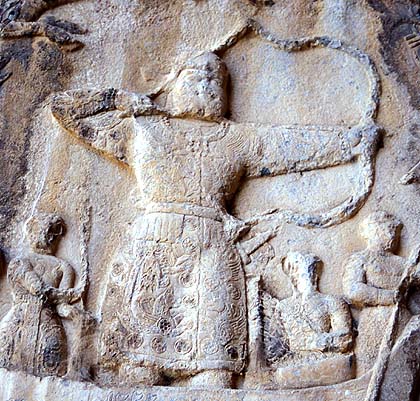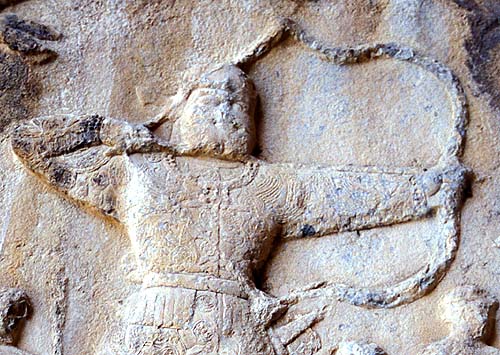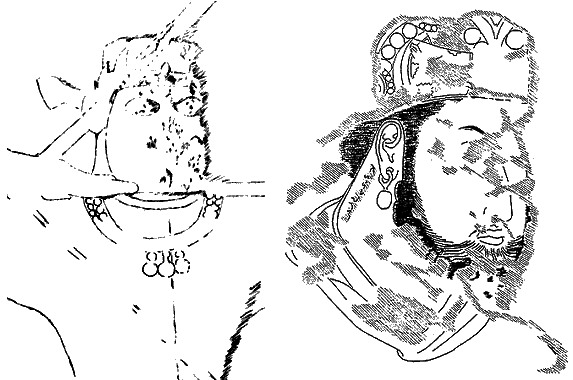
| Court art of Sogdian Samarqand in the 7th century AD | |||||||||||||
| Home | General | Western Wall | Northern Wall | Eastern Wall | Southern Wall | Bibliography | |||||||
 |
|
|||||||||||||||||||||||||||||||||||||||||||
Western wall
It is not only the Senmurv-device the Sasanian kings share with figure 4 of the Afrasiab murals. If we have a look on the royal images at Taq-e Bustan1, we immediately notice a general resemblance of the persons:
 |
Left: Sasanian king with Senmurv-patterned caftan, Taq-e Bustan, Great Ivan, left wall. |
| Right: Close-up of the above image |  |
King no. 4 from the Afrasiab and the Taq-e Bustan kings not only wear similar clothes, they have similar crown-caps (not state-crowns), beards and a certain "bull-neck".

Our conclusion is: Delegates-group A2 originates from a "western" country. With figure 4 at least one person in this group should represent a Sasanian king. And if our explanations concerning the date of the Afrasiab paintings are correct, this king may be even named: Yazdgard III - the last of his line on throne. As a member of delegates-group A2 the Sasanian king moves towards the (supposed) image of the Western Turk ruler.
With this the Afrasiab paintings throw a spotlight on the decline of the Sasanian empire. The entire situation is conceivable only for the forties or beginning fifties of the seventh century: After a series of lost battles against advancing Muslim troops the Persian king retreated to the eastern provinces and he contacted the Tang emperor (what an illusion!). Certain accounts in Tabari's history suggest that the king even crossed the Amudarya to meet the Sogdian king and the Western Turk ruler. The end came in AD 651-652 (=Hejra 31) in the region of Marv...2
| 1 - This is not the place to discuss in detail all the complicated problems concerning the date(s) of the Taq-e Bustan rock pictures. Only one statement: In our opinion the side walls of the Great Ivan of Taq-e Bustan seem to have been created not earlier than the end of the 6th or beginning of the 7th century. We are inclined to plead for a date later than Khusrow II, although it is impossible to say that with certainty. Anyway, there is only a small chronological interval between the rock carvings and the Afrasiab murals. | |
| 2 - The sources concerning all these events are difficult to interpret. There is nothing secure, even the episode of Yazdgard's death at Marv. We believe the Sasanian king to have been in the east already in the forties and not as late as AD 650/651 (this last date is the common opinion). |
Back to previous page on the identification of figure 4.
Back to first page on the identification of figure 4.
Read about figure 4A, preceding figure 4
Back to main text (western wall)
 |
|
|||||||||||||||||||||||||||||||||||||||||||